The human impact on our planet is immense and extremely rapid. An increasing human population size has led to unprecedented changes in land use, pollution and climate1. Over half of humanity now lives in cities (over 80% in many EU countries), and this proportion, along with the surface of urban lands, is expected to rise continuously during this century2. Urban areas can impose strong selection pressures that differ from more natural areas including increased temperatures due to human constructions and the loss of vegetation (Urban Heat Island effect3), and green space loss and fragmentation by buildings, which results in an overall biodiversity loss and biotic homogenisation as few tolerant species will dominate biological communities4,5.
This poses an enormous challenge for all organisms living in these areas but also provides an opportunity as cities across the planet share many commonalities, making them widely replicated and valuable “natural experiments6,7 that test how relevant and globally-acting environmental changes affect not only ecological but also evolutionary processes8,9. Recent research in Flanders shows that decreasing species diversity, biomass and homogenization across cities is prominent in arthropods4,10,11. For spiders, urbanization is linked to an overall community-wide decrease of spider size, and altered energetic allocations into different components of web-building12. As a result, orb web spider communities in cities are dominated by smaller species, with species relying on smaller prey and webs for prey-capture. Such functional shifts were also found at the intraspecific level in the European garden spider Araneus diadematus10 with urban cross spiders being smaller, catching smaller prey using webs with a smaller mesh width. This species is particularly interesting as it not only demonstrates behavioural web-building adaptations to urbanization, but also is characterized by a continuous colour variation ranging from light yellow/brown to dark (red) brown and greyish black which likely plays a role in thermoregulation13. Moreover, this species is an ideal study species in an urbanization context as it is:
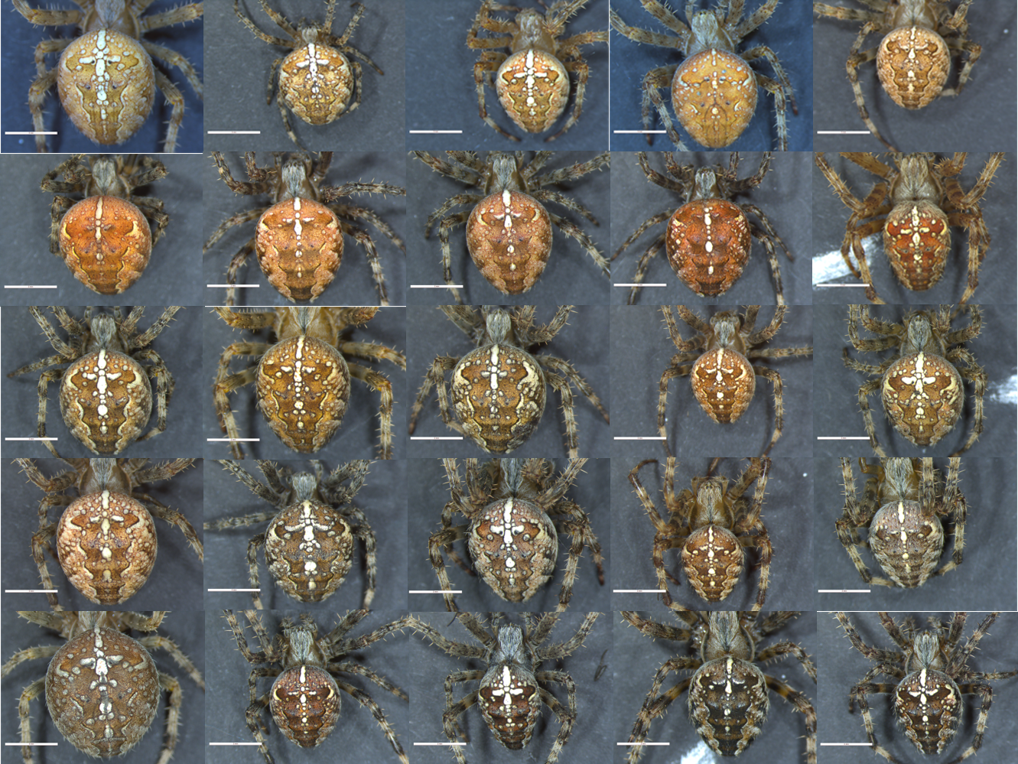
The European garden spider is one of the species of interest for the SPIN-CITY project which investigates the effect of urbanization on spiders using citizen scientists, in close collaboration with biologists. This project aims to further expand knowledge on web building behavior and investigates the effect of urbanization on spider colour (see info section). By taking pictures using the SpiderSpotter app and noting down web characteristics we investigate the following hypotheses:
Launched in September 2019, SPIN-CITY has mainly focused on Flanders (city of Ghent) (see map). Now, almost one year later, we would like to expand our research efforts and are looking to establish a large scale research network of collaborating scientists. By replicating across cities we will not only get an in depth understanding of the effects of urbanization on spider colour and web building, but this will also allow to determine which city characteristics (size, habitat connectedness,…) and to what extent latitudinal effects play a role in selection strength.
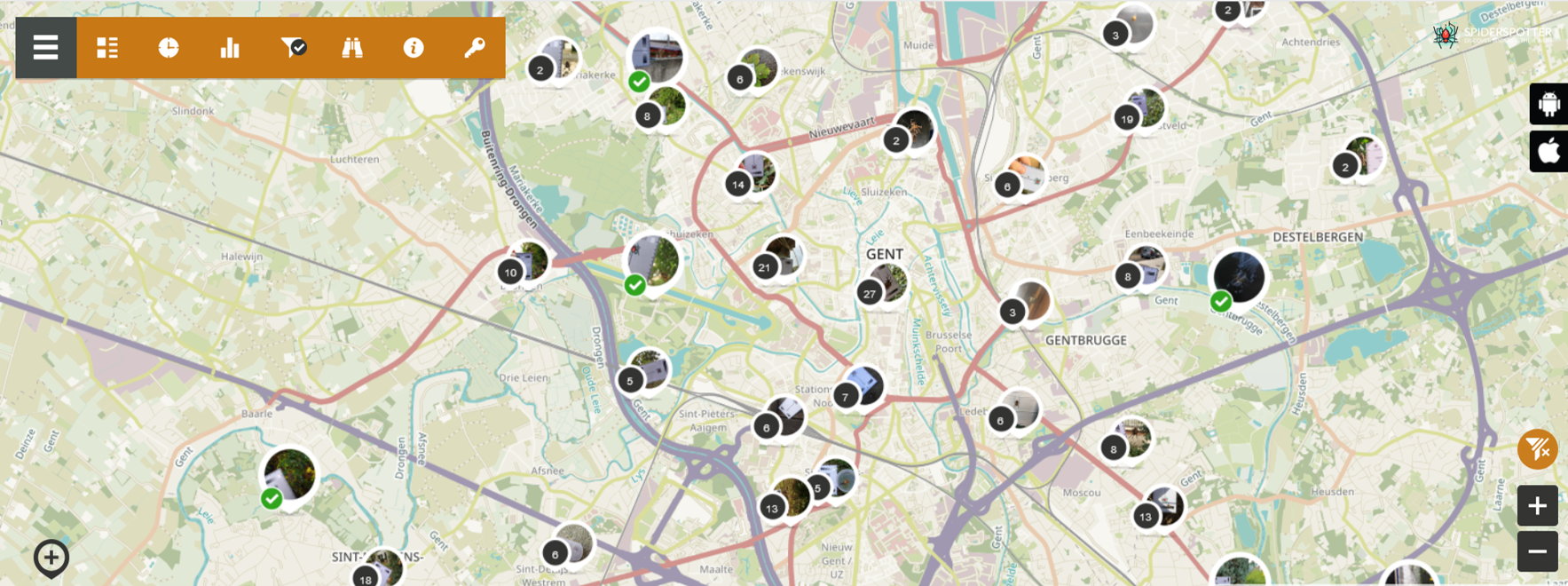
Current sampling locations for Araneus diadematus in the Ghent area (see www.spiderspotter.com/en/map).
If you are interested in collaborating on this research project, you are most welcome to contact us at This email address is being protected from spambots. You need JavaScript enabled to view it.. We will get back to you as soon as possible to discuss further arrangements including sampling protocol and answer any questions. In the meantime, have a look at our presentation about the project! In addition, you will be able to register for an online meeting at the end of August where we will give more background info on the project, present preliminary results and further streamline research efforts. Of course, project development will be dependent on the evolution of corona measures and we will evaluate the country specific conditions at the end of August as well.
What is expected?
The strength of the research network lays in sampling a large number of cities across Europe. Field work will consist of taking spider pictures using the SpiderSpotter app along an urban-rural transect and taking web measurements: length of the capture spiral and number of crossing threads which gives an estimate of the average mesh width. Sample locations should be selected to represent a varying level of urbanization (rural, suburb, city centre). For a subset of cities, collaborators will be asked to collect live spiders to be analyzed at UGent. Location coordinates are automatically registered through the app. Sampling number will depend on city size and specific urbanization characteristics, but we aim to collect between 80 and 120 observations observations per city. This normally takes 2 – 3 days to achieve. The SpiderSpotter app serves as the primary input tool, but also as the central database for spider/web and location data (coordina
tes), so there is no need to individually transfer data.
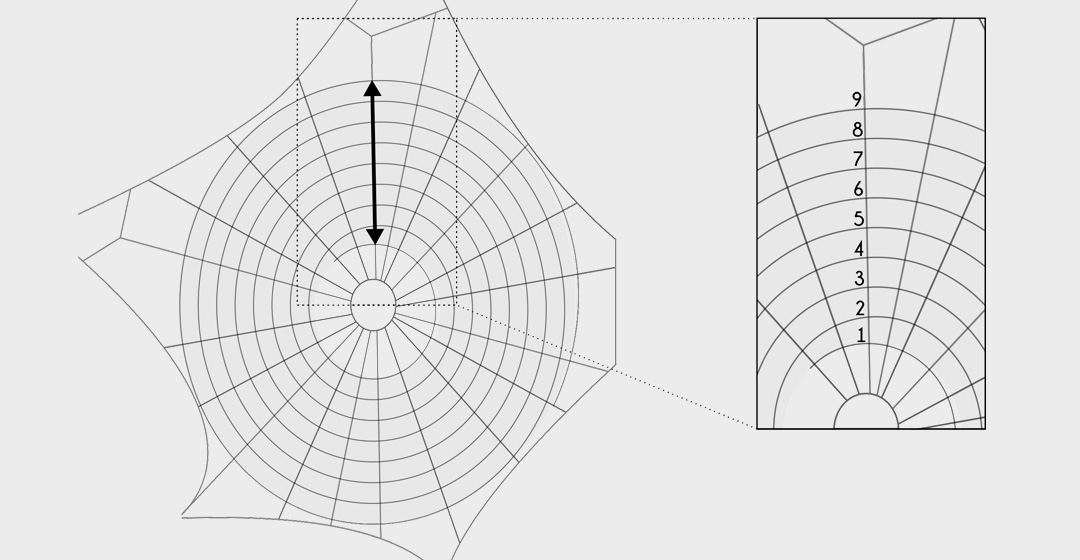
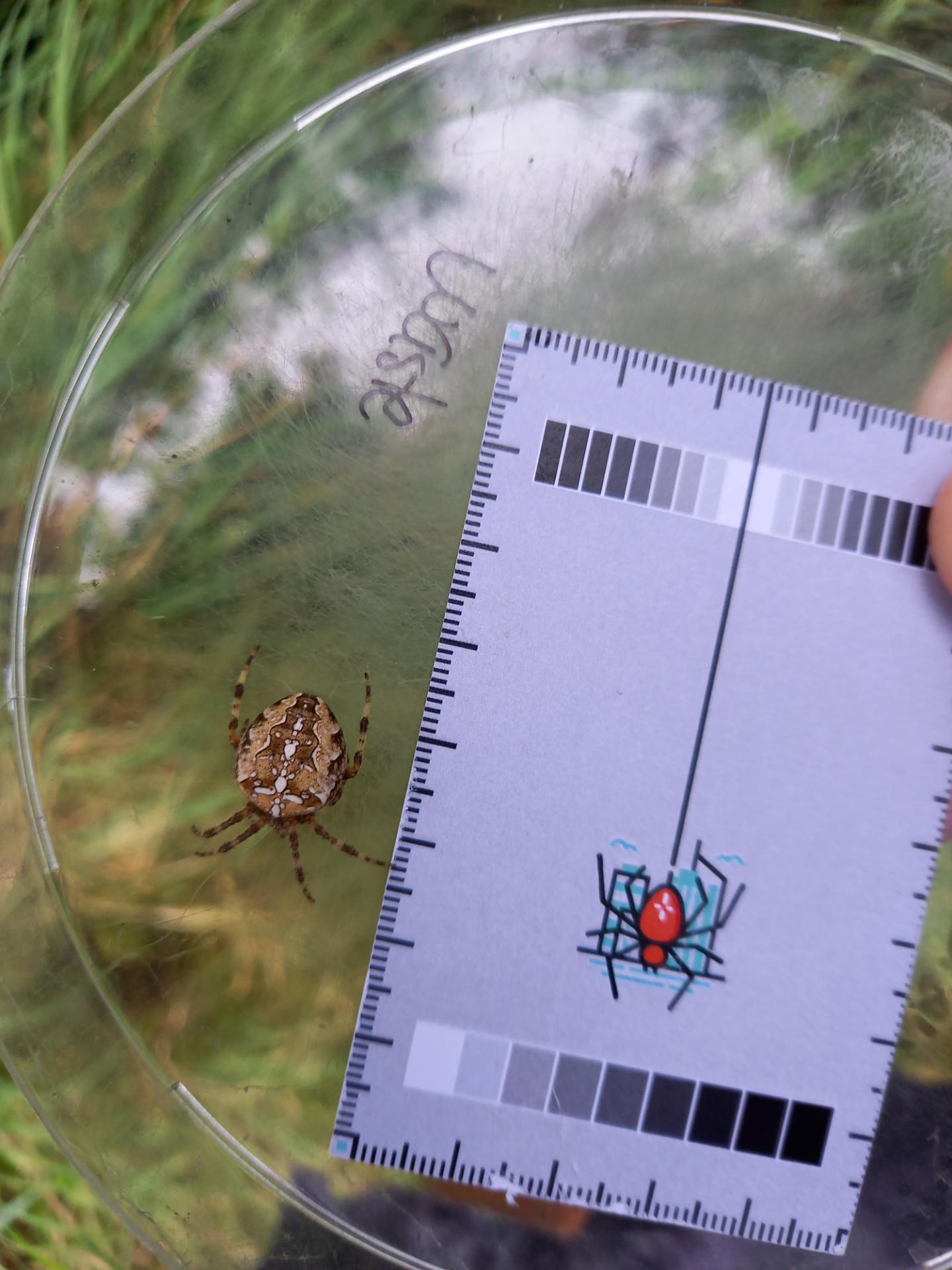
Illustration of how the length of the vertical radius of the web is measured + counting of the intersecting threads. It is easiest to take pictures of the spider in a large petridish with the spiderspotter card on the bottom. Try to make sure to have the camera perpendicular to the spider, with the length measure and one of the grey scales fully visible. Try to avoid over- and underexposure of the picture.
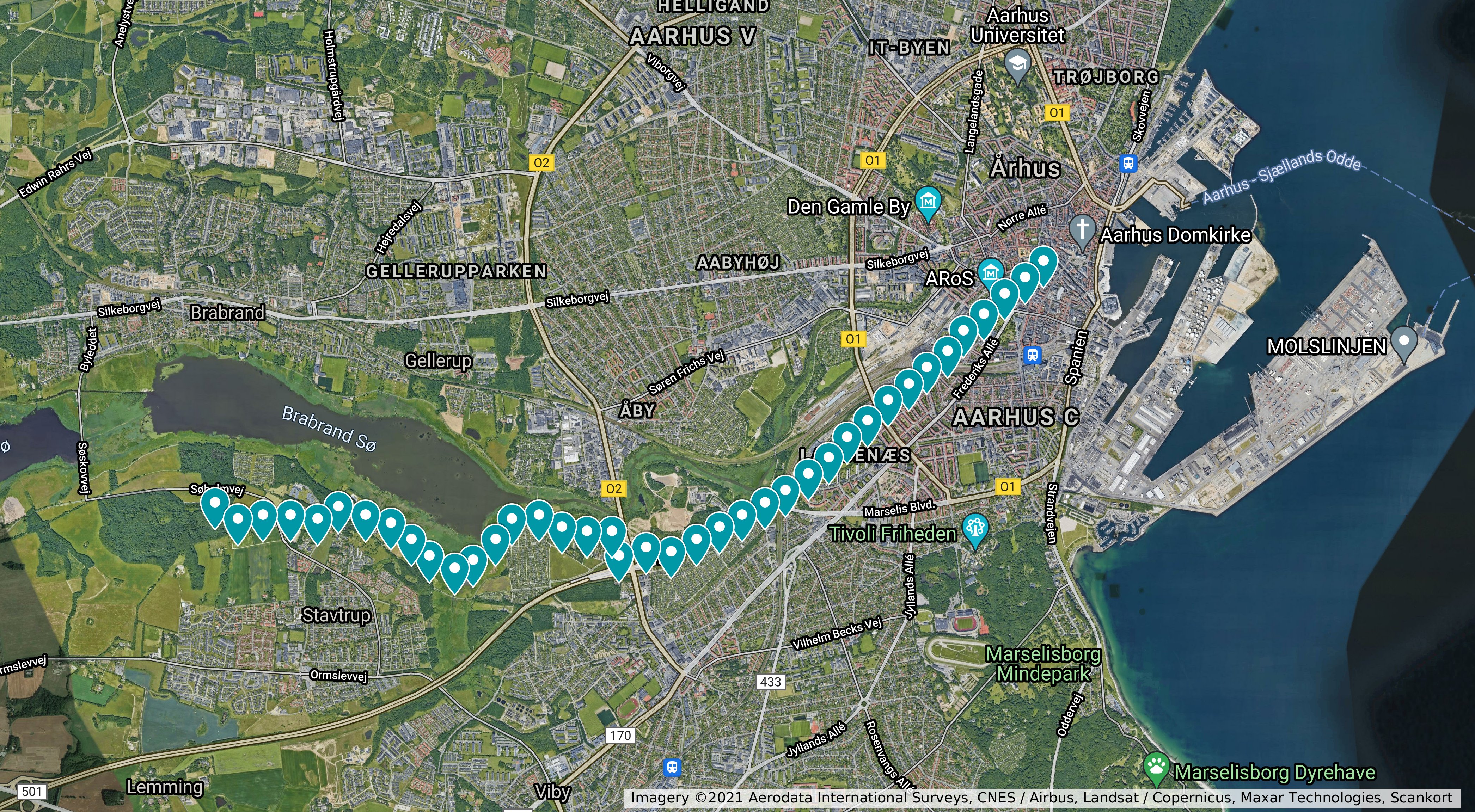
Example of an urban to rural transect in Aarhus (Denmark), with indication of the sampling locations.
Researchers at UGent will perform all the subsequent data analysis that will consist of:
Individuals or members of a team that perform field sampling (taking spider pictures + web measurements + sending of spider samples (in some cases)) will be considered full collaborators and will be offered co-authorship on papers resulting from the collected data. All data will be open and publicly available. We will soon provide more information on authorship and data policy.
Why is colour important for spiders?
Colour has many functions in spiders, for example the bright colours of male jumping spiders are a seductive display for females and the brown color of many wolf spiders is a way to camouflage themselves from predators. But did you know that colour can also play a role in heating and cooling? The principle is simple: dark surfaces heat up more and faster than lighter surfaces. This is because a dark colour absorbs more light (a black hole absorbs almost all light), which releases heat. A lighter colour reflects more light and therefore stays cooler.
That is why the color of a spider is very important because spiders are cold-blooded animals, meaning that they do not produce heat themselves and therefore assume the temperature of the environment. When it is warm outside, they get warm. If it is cold outside, they get, you guessed it, cold. The opposite are mammals, like humans, we actually always have a more or less constant temperature. A dark spider will therefore heat up more than a light spider.
But how hot can a spider get? With the heat camera we went out in July during a heat wave and we found some spiders in the sun!
Among the grass we found a Wasp spider, which easily reaches 30 °C Celsius. On a white wall we found a Zebra Jumping spider that had a somewhat higher temperature: 39 °C. This species is often found on warm walls and feels completely at home there! The record was broken by a dark Walnut Orb Weaver with a temperature of 43 °C. A bit strange, as this is actually a night-active species that is normally not seen during the day. This particular female hides under the rain gutter, it was probably a bit too hot there and she tried to cool down in the open air.
It is clear that spiders in the sun can get surprisingly hot! Perfect for investigating whether a light color can help them to stay cool!
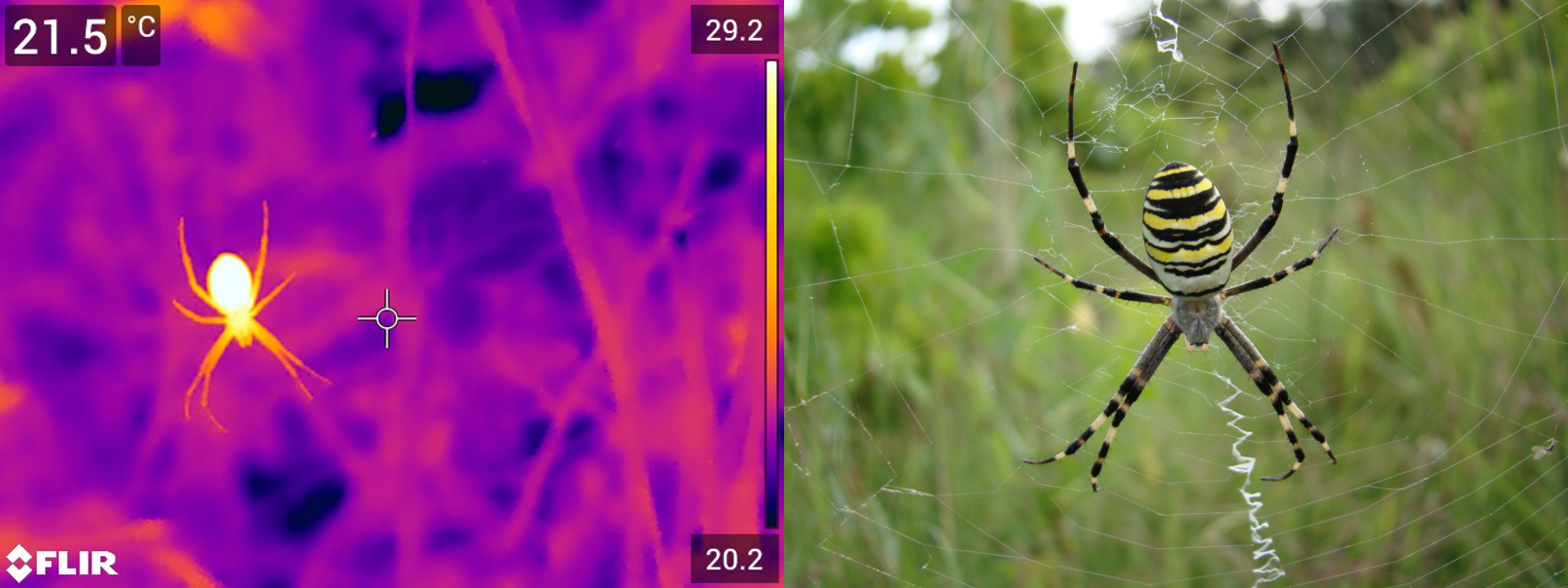
Wasp Spider (©Bram Vanthournout, Danny Declercq).
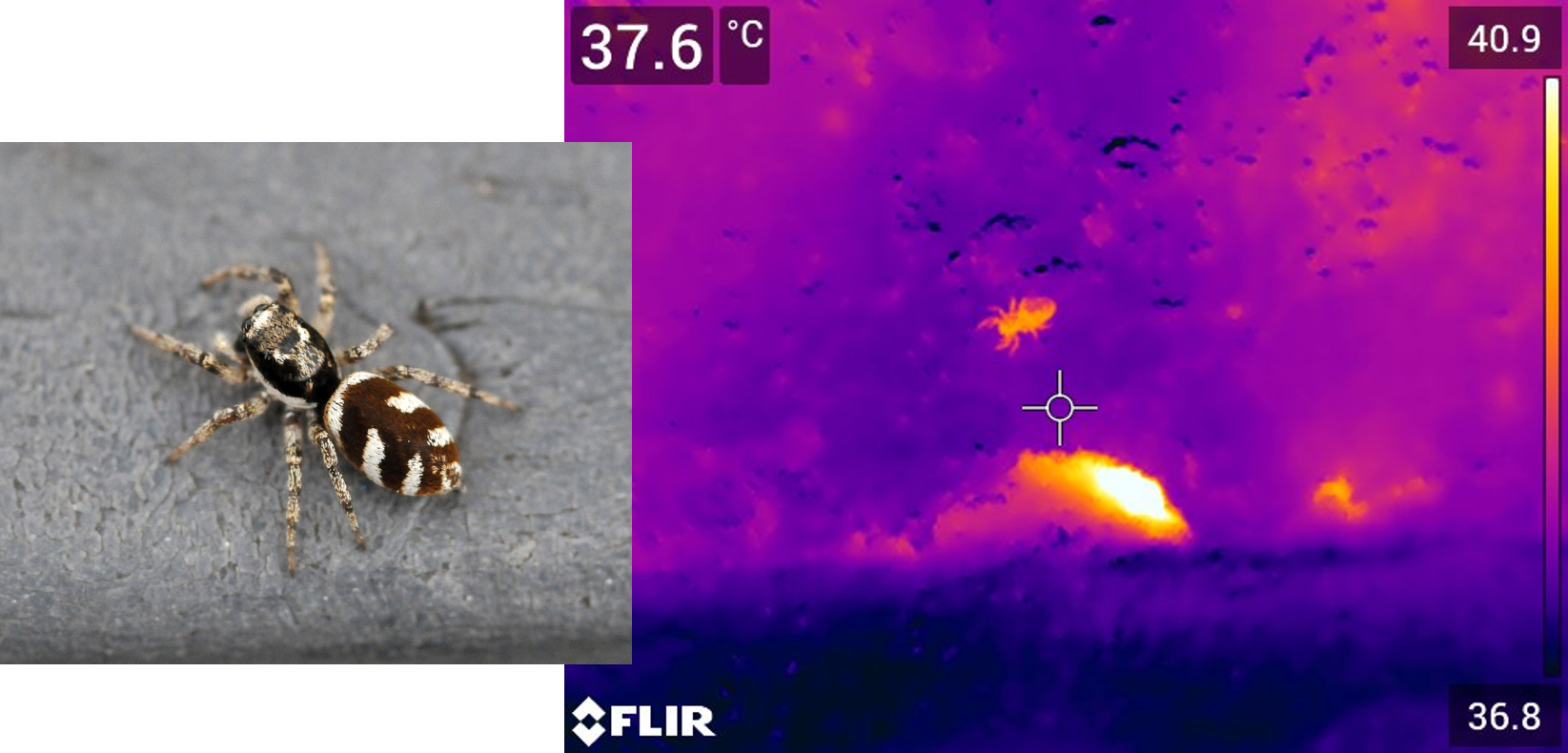
Zebra Jumping spider (©Luc Regniers, Bram Vanthournout)
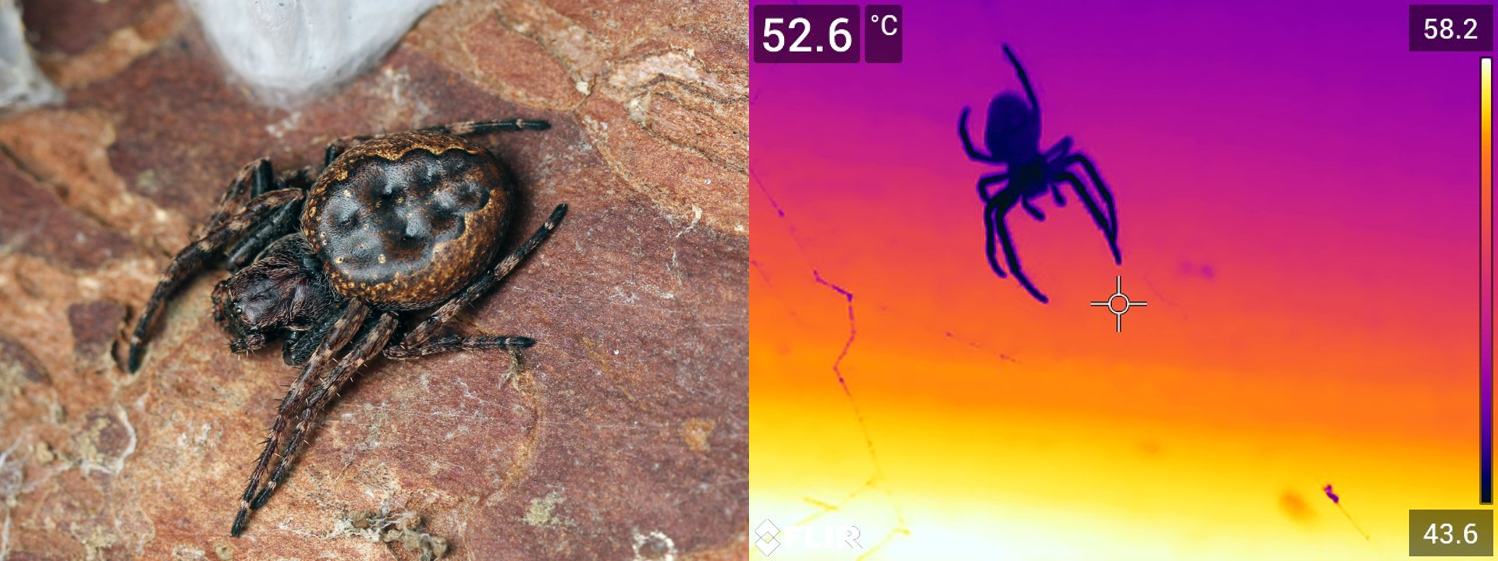
Walnut Orb Weaver (©Paul en Marianne Wouters-Horemans, Bram Vanthournout)
Well, you can do that by looking at the reproductive organs! In a female the epigyne is situated on the underside of the abdomen. In a male, there are two thickened pedipalps at the front of the head. They look like two "boxing gloves" and are usually clearly visible! So if you see two thickened and hardened structures on the head, then it is certainly a male. A female also has two pedipalps, but these are not used as a reproductive organ and are therefore not thickened.
P.S. The reproductive organs in spiders are a very important identification characteristics and in many cases often the only way to be able to say with certainty what species it is!
Females (left) and males (right). Top row: Nursery web spider (Pisaura mirabilis), male has only one pedipalp left and holds a nuptial gift in his jaws (©Leo Vaes en André Hermans). Middle: Spotted wolf spider (©Richard Louvigny en Danny Declercq). Lower row: Herb Hammock spider (©Pierre Oger en Bert Pijs).
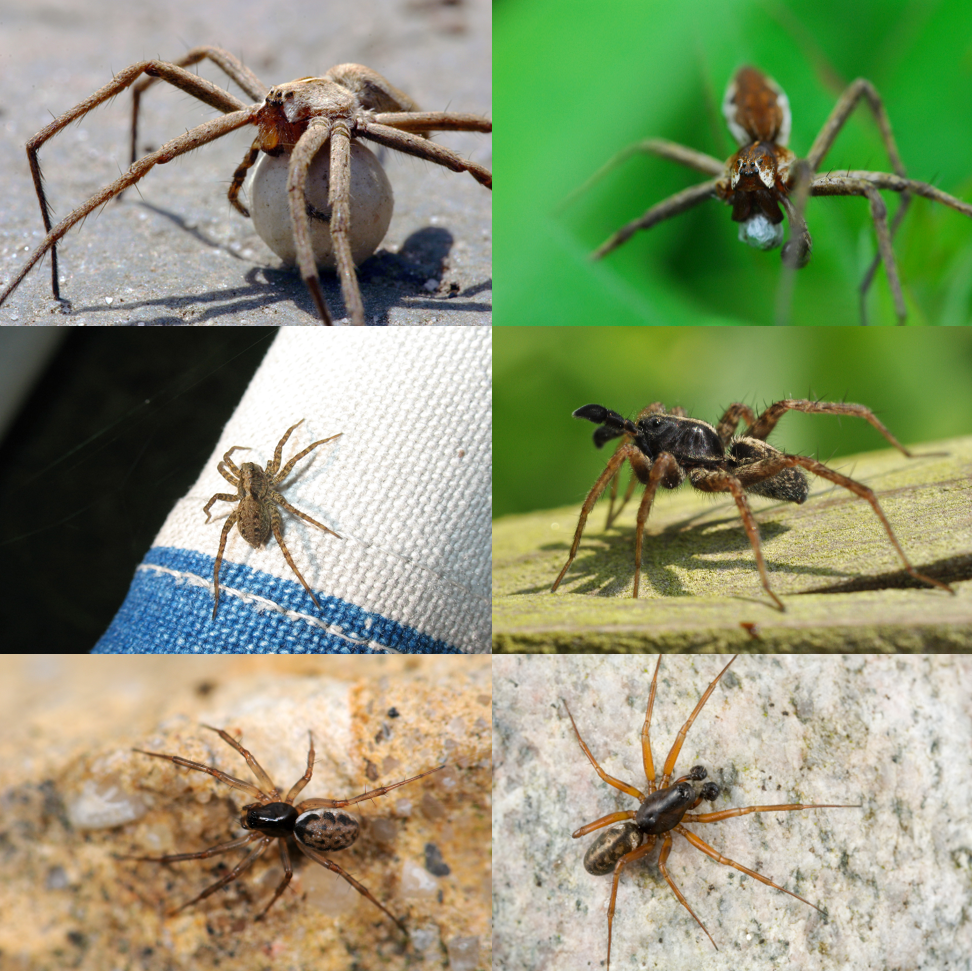
This includes various types of webs, all of which have an open, spatial and somewhat disorderly appearance.
The cob web of Cob web spiders (Theridiidae) consists of tangled, messy silk together with threads that are tightly stretched against the surface. These threads have small adhesive droplets. If a crawling insect gets stuck, the thread detaches and the prey is lifted off the ground. Another example is the cribellate web that also consists of messy threads and is spun by Hackled mesh weavers (Amaurobiidae). These webs can often be found against walls and do not contain any adhesive. However, the spider combs the silk with the hind legs making it very curly. This ensures that the web works like velcro and is a very efficient way to trap insects. The Cellar spider, which you often see in the corners of the garage, garden shed or bathroom, also makes a messy web.
Cob web
Cribellate web
Sheet webs look a bit like funnel webs because they also have a mat-like structure, but sheet webs don't have that many layers. The funnel-shaped retreat is also missing as the spider can often be found hanging upside down in the web. Just like the web of the Labyrinth spider, a sheet web has vertical threads above the sheet. These function to intercept flying insects and causes them to fall on the sheet. At that moment, the spider, hanging upside down, bites the prey through the web. On a morning with lots of dew, the sheet webs stand out in the grass. Only then can you see how many there are!
• Looks a bit like a mat
• Vertical wires
• Spider often upside down
• Sheet web spiders (Linyphiidae)
This is a simple, primitive web that consists of a silk tube from which various tripping wires extend. These webs are often made in a crevice in the wall or between tree bark. If a prey touches one of the trip wires, the spider quickly shoots out of its hiding place and grabs it. Due to the star-shaped position of the trip wires, the spider immediately knows where the prey is located! This type of web is made by the Six-Eye spiders (Segestriidae), of which the Segestria bavarica is a common species. During the day the spider hides in the tube, but at night it is ready to grab prey. Then you can see the front legs and part of the head sticking out!
• Silk tube
• Trip wires
• Six-eye spiders (Segestriidae)
Funnel webs are horizontal webs that look a bit like a mat. At the back there is a funnel-shaped retreat in which the spider hides. If a prey gets stuck on the web, the spider rushes out and drags the prey into the funnel where it gets eaten. These webs are often made in a corner and can be very large and noticeable. The best known funnel webs are those of the house spiders, you can often see these webs in the corner of the garage, garden shed, basement, etc.
The Labyrinth spider, which is related to the house spiders, adds something extra to its funnel web. Vertical threads allowing for also flying insects to get caught. They fly against the threads and fall on the web. You can see these webs in the summer on low vegetation, often in large numbers!
• Flat web
• Looks like a mat
• With funnel-shaped shelter
• House spiders (Agelenidae)
This is the typical web that you see in front of the window and that is often stretched out between plants. It’s a flat, round web that is easily recognized as it resembles a wheel. The support threads that run from the centre of the web look like wheel spokes. There is no adhesive on these threads, the spider uses them to move about in the web. One of these threads functions as a signal wire that transmits the vibrations and alerts the spider. If you follow this thread, you will find the spider!
The web also has spiral wires with small droplets of adhesive to catch prey. But also on these threads orb web spiders don’t get stuck, they have special claws on their feet so they can move around the web easily.
Sometimes you see silk in a zigzag pattern in the middle of the web. This is called the stabilimentum. Some spiders decorate their web with it to lure prey, camouflage themselves and make the web stand out for birds so they are less likely to fly through it.
• Flat, round web
• Vertical or horizontal
• Spokes and spiral wires
• Sometimes stabiliment
• Made by wheel web spiders (Araneidae), Stretch spiders (Tetragnathidae) and cribellate orb weaver spiders (Uloboridae)
At the heart of every citizen science project are of course the citizens. Your observations are crucial for the project and really help to understand how spiders can adapt to city living! Thank you for that and keep spotting!
There is a core team of biologists from Ghent University behind the Spider-City project and the SpiderSpotter app. They work together with experts from ARABEL (Belgian Arachnological Society) and Natuurpunt. If you want to know more about the Spider-City people, feel free to have a look at the bio’s below! For the specific development of the app, we worked together with SPOTTERON Citizen Science whose extensive experience in citizen science made sure that the app is userfriendly and working smoothly!
Feel free to contact us at This email address is being protected from spambots. You need JavaScript enabled to view it.!
 |
Bram VanthournoutBram Vanthournout is a biologist and researcher at UGent at the EON research group (Evolution and Optics of Nanostructures). He studies spiders to solve evolutionary questions. For example, he investigated why some spider species have more females than males (spoiler: bacteria that kill males but leave females untouched are the cause). He is currently investigating whether spiders can adapt to city life through color in the SPIN-CITY project. |
|
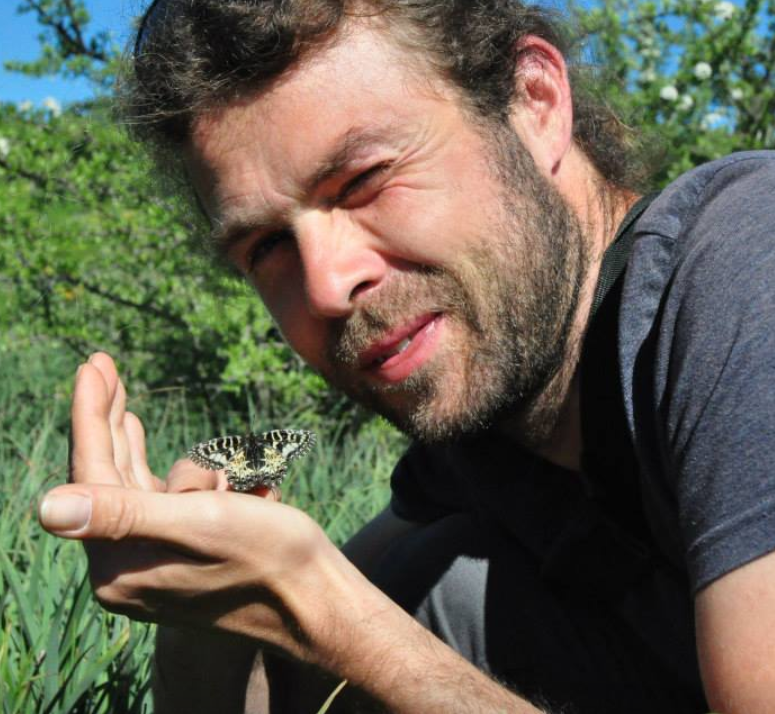 |
Pieter VantieghemPieter Vantieghem works at the Terrestrial Ecology Unit of Ghent University as a lab technician. He is helping with the research of the unit in the lab as well as in the field. He is a biodiversity expert with extensive experience in working with birds and all kinds of arthropods like butterflies & moths, flower flies & other pollinating insects and spiders. As a voluntary validator of butterfly sightings on Flanders’ biggest biodiversity citizen science website waarnemingen.be he also has a good experience in translating science to the less experienced. |
|
 |
Katrien De WolfKatrien De Wolf is a PhD student at Ghent University within research groups TEREC and EON. She -works on the SPIN-CITY project, studying the trophic and thermal adaptation of the European garden spider (Araneus diadematus). Katrien has a keen interest in the diversity of arthropods, including solitary bees, moths, mosquitoes, ground beetles and recently added spiders to this list! |
|
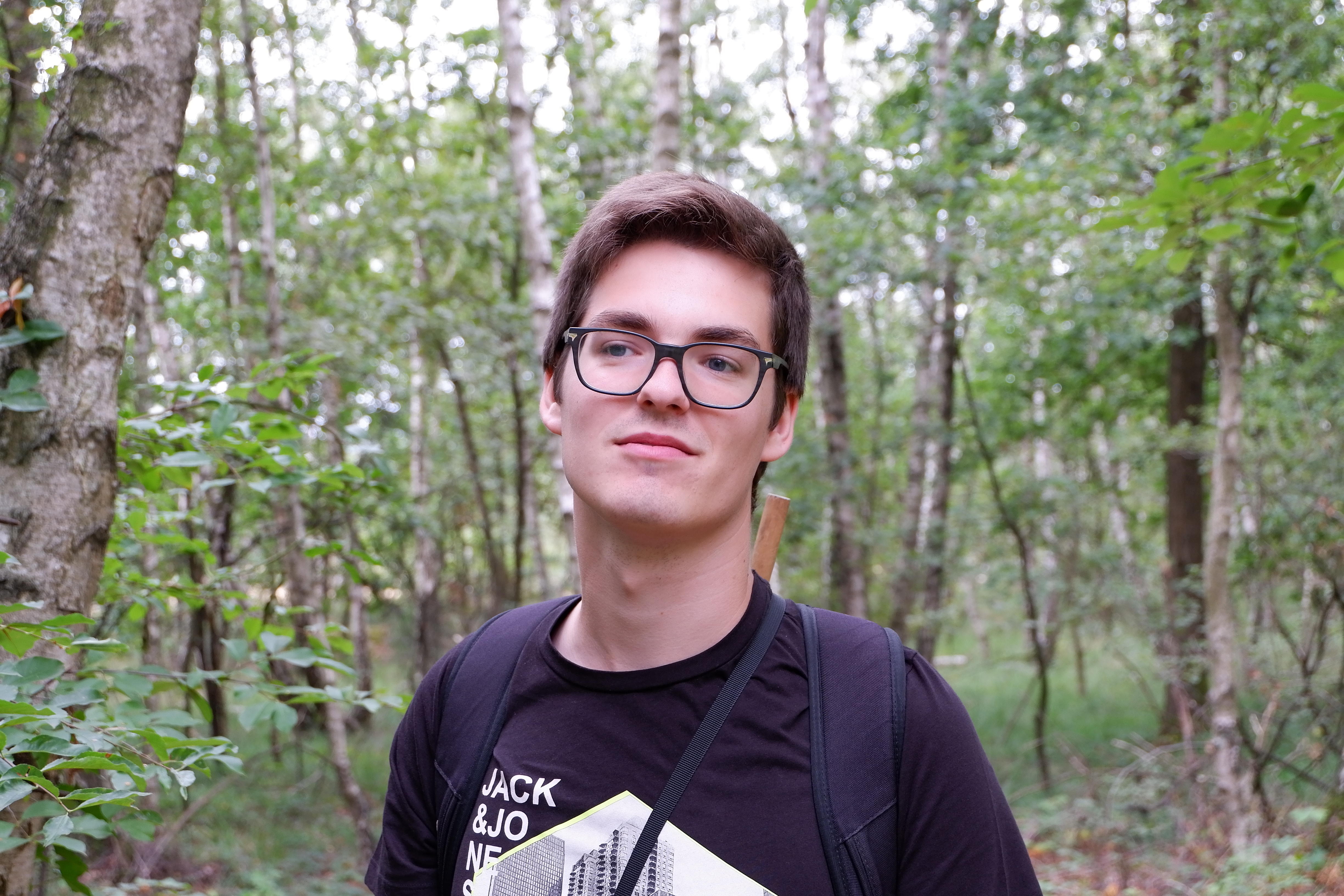 |
Garben LoggheGarben Logghe is a PhD student at Ghent University within research group TEREC. His FWO project, that is supervised by both Dries Bonte and Dirk Maes (INBO), focuses on connectivity conservation of arthropods under climate change. This means that he’s studying the ability of insects and spiders to mitigate the effects of global warming by dispersing to cooler regions. Both life-history traits of the species (body size, mobility, demography…) and the environmental context are considered. Besides this research, he spends a lot of his free time on studying spiders, including voluntary validating spider observations on the website Waarnemingen.be. |
|
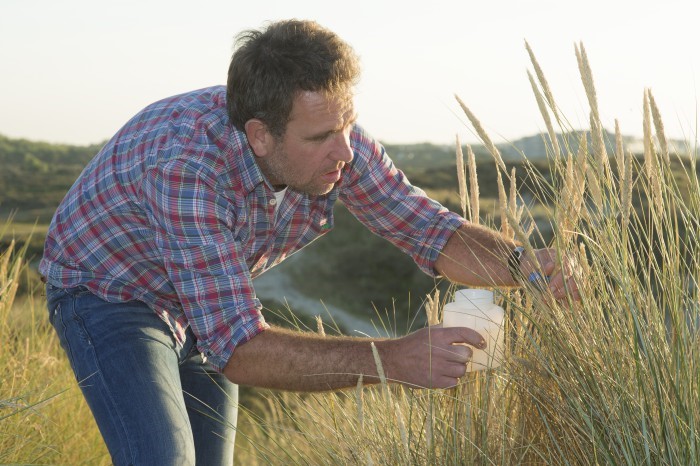 |
Dries BonteDries Bonte is professor in ecology and evolution at Ghent University. He leads his ‘Spatial Ecology and Evolution’ research group at the Terrestrial Ecology Unit and is editor-in-chief of Oikos – a journal for synthesis in ecology. His research includes:
He uses arthropods -and especially arachnids- as a biological model, and combines experimental approaches with modelling to gain a firm understanding on how habitat fragmentation, climate change and urbanisation affect biodiversity at multiple levels of biological organisation. |
|
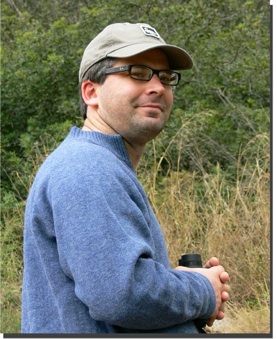 |
Matt ShawkeyI am a professor in the biology department at the University of Ghent, leading the research group “Evolution and Optics of Nanostructures.” In this group, we study the properties, mechanisms, development and evolution of animal colors using a variety of field- and lab-based techniques. Of particular interest are colors produced by highly ordered nanostructures, and/or from melanin pigments. A new focus in our lab is on the thermal properties of animal coloration. |
|
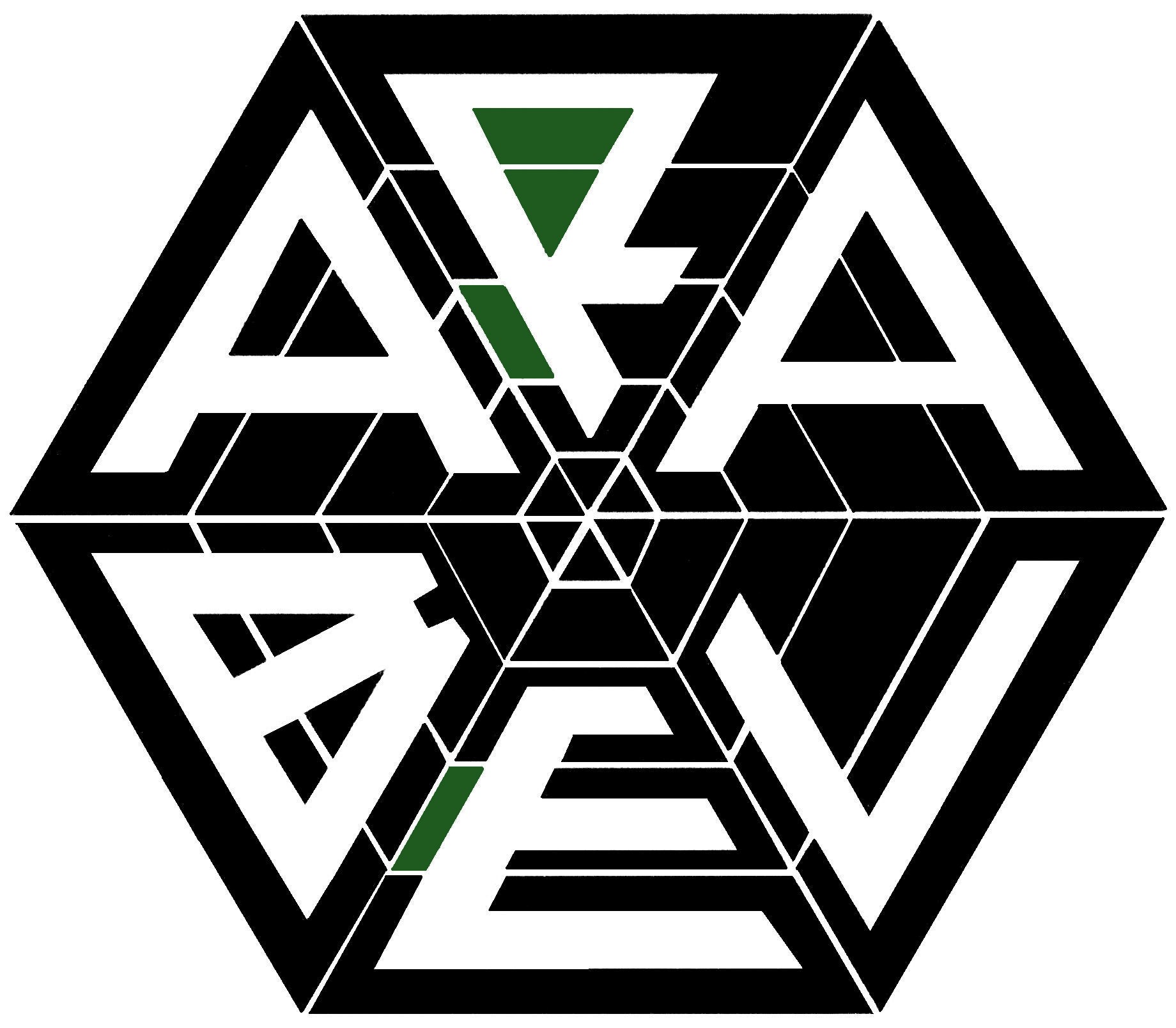 |
Koen Van KeerAt the age of 4, Koen Van Keer (° 1969), together with his 4-year older brother Johan, started collecting and studying spiders. In the 1980s the brothers became active within the Belgian Arachnological Association ARABEL, of which Koen became secretary in January 2004. |
|
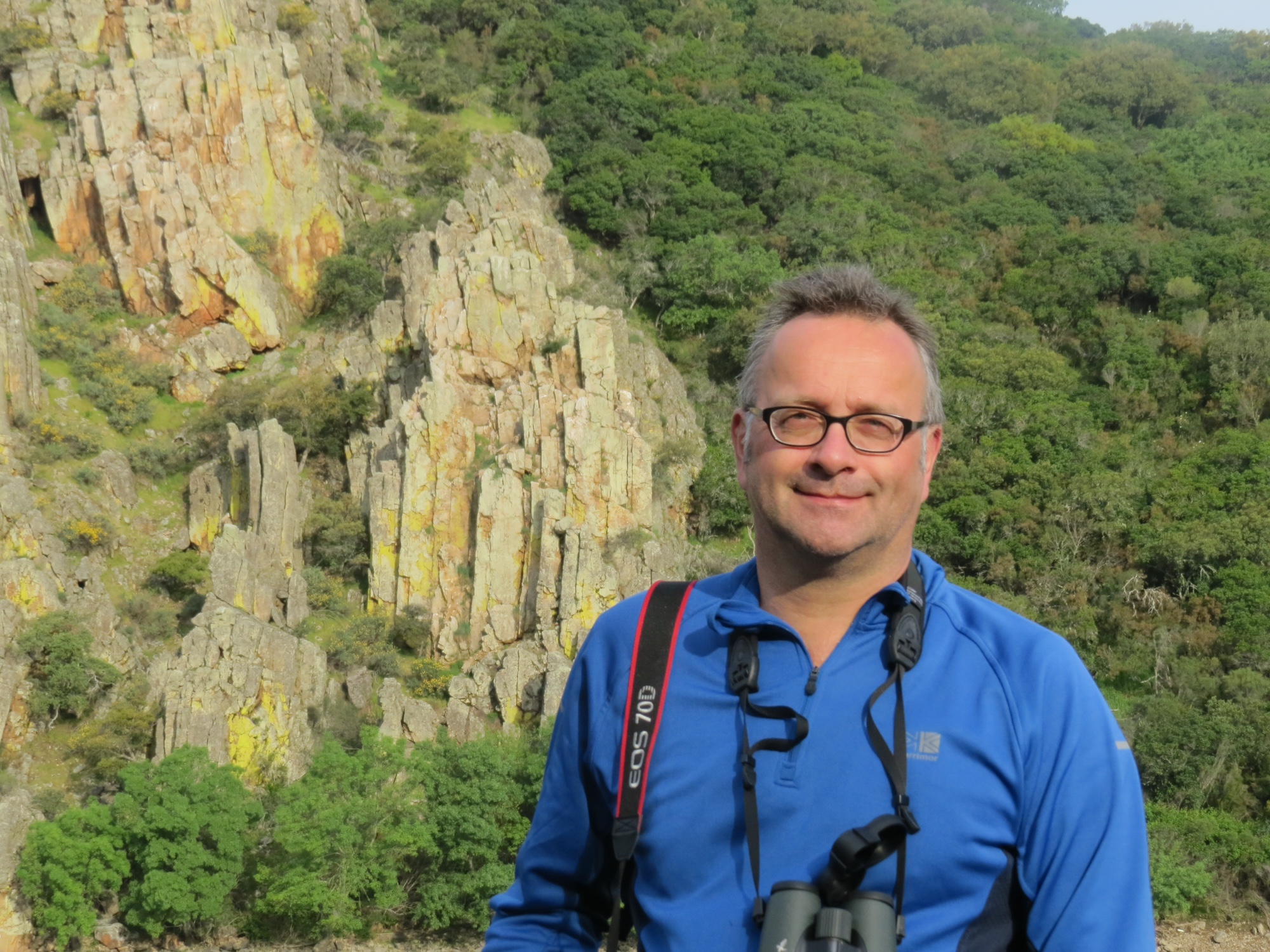 |
Mark Alderweireldt is an ecologist and taxonomist working at the Environmental directorate of the Province East Flanders and as visiting researcher at the Terrestrial Ecology Unit of Ghent University and the Royal Museum of Central Africa in Tervuren. His research topics involve biodiversity, applied ecology, taxonomy, zoogeography, bio-indicator value, pest control potential and nature conservation related to spiders and other important taxonomic groups such as carabid beetles and myriapods. He also specialised in the taxonomy and distribution of European, African and Arabian spider faunas, especially Lycosidae (wolf spiders). |
|
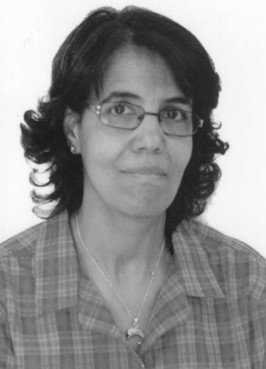 |
Lynda Beladjal is a PhD taxonomist and ecologist at Ghent University within research group Terrestrial Ecology. Her research interests are principally on drought and temperature sensitive habitats in arid areas (deserts). Besides her works on some Crustacea groups (Large Branchiopoda), she also works on some other Arthropoda groups mainly Aranea. She is one of the specialist in the taxonomy, systematic and ecology of North African spiders. She described more than 30 new species mostly Dysderidae (woodlice spiders) in the Maghreb region in general and in Algeria in particular. |
Pieter Vantieghem works at the Terrestrial Ecology Unit of Ghent University as a lab technician. He is helping with the research of the unit in the lab as well as in the field. He is a biodiversity expert with extensive experience in working with birds and all kinds of arthropods like butterflies & moths, flower flies & other pollinating insects and spiders. As a voluntary validator of butterfly sightings on Flanders’ biggest biodiversity citizen science website waarnemingen.be he also has a good experience in translating science to the less experienced.